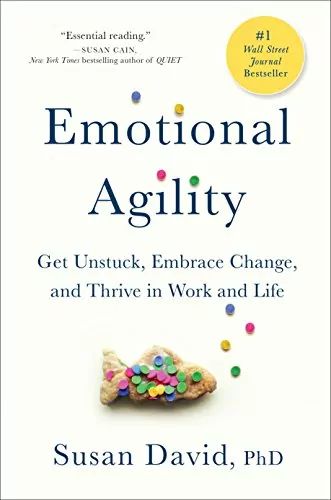Emotional Agility book summary is the topic of this blog post!
Emotional Agility: Get Unstuck, Thrive, and Embrace Change in Work and Life, by psychologist Susan David, is an insightful guide for embracing life’s uncertainties and complexities. It is a science-backed approach to navigating one’s emotions and aligning them with core values. The book is based on an earlier paper co-written with Christina Congleton and published in the Harvard Business Review.
As someone who’s dedicated years to educational studies and a lover of reading, I was drawn to this concept and how it might apply to teaching, parenting, and personal development. Here’s an extended review of the book that I hope will resonate with fellow educators, parents, and lifelong learners.
What is Emotional Agility?
According to Susan Davis, emotional agility “is a process that allows you to be in the moment…[it] isn’t about ignoring difficult emotions and thoughts. It’s about holding those emotions and thoughts loosely, facing them courageously and compassionately, and then moving past them to make big things happen in your life.”
Along these lines, emotional agility, as conceptualized by Susan Davis, represents a conscious and deliberate approach to life that encourages being present with our emotions and thoughts. Rather than shunning or suppressing the difficult and uncomfortable feelings, it emphasizes acknowledging and accepting them with courage and compassion.This doesn’t mean dwelling on these emotions but holding them lightly, examining them without judgment, and then moving forward.
It’s akin to a dance with our inner selves, where we recognize the music of our emotions but don’t let them dictate our actions. This process fosters a kind of inner strength and flexibility that empowers us to pursue our goals and aspirations without being hindered by negative self-talk or fear. By embracing this concept, we can create meaningful change in our lives, aligning our actions with our values, and opening up new possibilities.
1. Rigidity to Agility
The initial chapter serves as an eye-opener about the paradox of emotional rigidity. While rigidity can provide short-term comfort, it often leads to long-term stagnation. On the other hand, emotional agility allows for a more nuanced response to life’s challenges. This chapter made me reflect on my teaching years and how flexibility in thinking can foster creativity and resilience in both educators and students.
2. Hooked
We often become “hooked” to emotions like anger, fear, or self-doubt. David explains these hooks with clarity, backed by real-life examples, creating a vivid picture of why we often feel stuck. This part made me ponder my experiences in reviewing edtech tools, where sometimes biases can ‘hook’ our judgment.
3. Trying to Unhook
This section offers practical solutions to unhook from emotional traps. With guidance grounded in scientific research and psychology, David provides strategies that anyone can implement.
4. Walking your Why
This chapter’s focus on aligning actions with values is paramount. In education, aligning teaching methods with the core mission of empowering students is something I often emphasize in my blog posts. David’s insights here are a reaffirmation of the importance of this alignment.
5. Moving on – The Tiny Tweaks Principle & The Teeter-Totter Principle
The approach of making small, impactful changes (tiny tweaks) and maintaining a balanced perspective (teeter-totter) can apply to various aspects of life. I see these principles as particularly useful in fine-tuning teaching methods and helping children navigate their emotions.
6. Emotional Agility at Work
This chapter, filled with insights applicable to workplace dynamics, could be instrumental for school administrators and educators looking to foster a more empathetic and agile environment.
7. Raising Emotionally Agile Children
As someone who’s passionate about helping educators and parents, this section struck a chord with me. It provides not just theoretical knowledge but also actionable strategies for raising emotionally intelligent children.
My Take
I have recently read a review of Susan Davis book written by Altman Yochanan and I can’t help but share many thoughts with him. Yochanan recognizes the book as a self-help guide focusing on emotional mental health and likens its core concept to what’s commonly understood as “mindfulness.”
He astutely observes the connections between emotional agility and cognitive-behavior therapy, such as acceptance and commitment therapy. He also points out that David’s terminology might be a novel addition, introducing readers to terms like “hooks” for negative thoughts and “brooders” or “bottlers” for emotional handling, though the ideas themselves are not new.
I concur with Yochanan that David’s use of unique language adds a freshness to familiar concepts, and I see value in the accessibility of her writing style. However, I also acknowledge his concern that the book might be seen as a retelling of existing ideas. In the world of teaching and pedagogy, we often see a similar pattern where existing principles are repackaged under new terms.
But unlike Yochanan who suggests that the book might have been a sensation 20 years ago but is now a retelling of what’s in the public domain, I see the power of revisiting and reframing these concepts. The classroom, the workplace, and personal relationships constantly evolve, and fresh perspectives on enduring ideas can foster renewed understanding.
Moreover, Yochanan’s emphasis on the book’s relevance not only to specific emotional struggles but also to broader life scenarios, such as work-related stress or financial worries, resonates with my own thoughts on the book’s applicability in various domains. The chapter on “emotional agility at work,” which he specifically highlights, could indeed be valuable for educators, administrators, or anyone navigating professional relationships.
Finally, David’s use of clear language, practical illustrations, and self-disclosures aligns with the empathetic and engaging writing that I value. Her personal touch adds a layer of authenticity, which makes the reading experience more relatable.
Emotional Agility Quotes
Here are some interesting quotes that stood out to me from reading Emotional Agility:
- “Courage is not the absence of fear but fear walking.”
- “When we show up fully, with awareness and acceptance, even the worst demons usually back down. Simply”
- “We still don’t like the things we don’t like –we just cease to be at war with them. And once the war is over, change can begin.”
- “The most effective way to transform your life, therefore, is not by quitting your job and moving to an ashram, but, to paraphrase Teddy Roosevelt, by doing what you can, with what you have, where you are.”
- “The parent who praises a child’s accomplishment by saying, ‘You studied hard!’ promotes a growth mindset. The parent who says, ‘Look at your A, son! You’re a genius!’ promotes a fixed mindset.”
- “Life’s beauty is inseparable from its fragility.”
- “Life is full of diving boards and other precipices, but, as we’ve seen throughout this discussion of emotional agility, making the leap is not about ignoring, fixing, fighting, or controlling fear—or anything else you might be experiencing. Rather, it’s about accepting and noticing all your emotions and thoughts, viewing even the most powerful of them with compassion and curiosity, and then choosing courage over comfort in order to do whatever you’ve determined is most important to you. Courage, once again, is not the absence of fear. Courage is fear walking”
- “Emotional agility is about loosening up, calming down, and living with more intention. It’s about choosing how you’ll respond to your emotional warning system.”
Conclusion
Emotional Agility is not a quick fix; it’s a lifelong approach to embracing change and growth. Susan David’s rich experience, combined with humor and compassion, makes this a must-read. From a personal standpoint, the concepts in this book echo many of my own beliefs and practices in education and personal development. They offer insights that can be readily applied to teaching, parenting, and indeed, to life.
A few questions, discussions, and reflections in the book could have been more elaborated to deepen the connection with readers. Nevertheless, this book serves as a substantial road map for real behavioral change and taps into a much-needed conversation in our ever-changing world.
For fellow teachers, educators, and parents, I highly recommend Emotional Agility. Its wisdom transcends beyond self-help, providing a new lens to view personal and professional challenges and successes. Whether it’s in the classroom, at work, or in raising children, the principles in this book can foster an environment of empathy, resilience, and continuous growth. It’s a read that will likely prompt you to look inward and spark a transformative journey.
References:
- Altman, Y. (2017). Emotional Agility: Get Unstuck, Embrace Change, and Thrive in Work and Life [Review of Emotional Agility: Get Unstuck, Embrace Change, and Thrive in Work and Life]. People & Strategy, 40(1), 58–. Human Resource Planning Society.
- David, S. and Congleton, C. (2013). Emotional agility. Harvard Business Review.
- Good Reads







